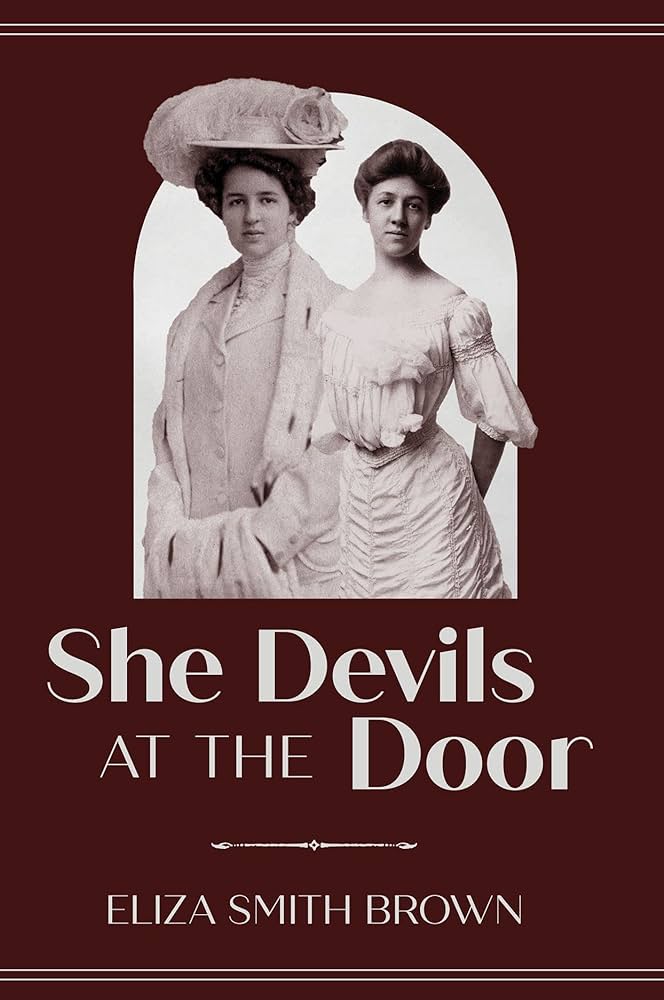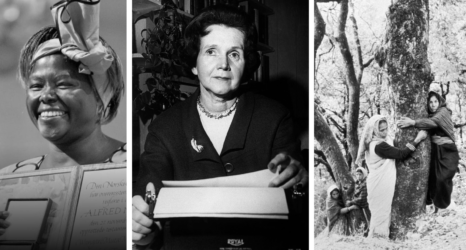She Devils at the Door tells the true story of two formidable sisters, Lucy and Eliza Kennedy, who came of age in Gilded Age Pittsburgh, graduated from Vassar College, and became leaders of the suffrage movement. But they didn’t stop after women won the vote in 1920. Instead, they spent 40 years fighting corruption in local government. In an election year, and amidst our current climate of civic skulduggery, these two uncommon women bear the hallmarks of folk heroes, armed with sufficient moxie to battle the gritty, scandal-ridden political machine with tenacity and wit.

The following is an excerpt from She Devils at the Door, published by Carnegie Mellon University Press, depicting some of the women-led opposition to the women’s suffrage movement.
As the suffrage movement gathered momentum, those who would thwart it were rallying their own troops. The National Association Opposed to Woman Suffrage (NAOWS) had been organized in 1911, with the support of some wealthy women, some Catholic clergy, and the distilling and brewing industries, who had every reason to fear the influence of women.
At a luncheon in New York, the group had declared that they would “follow the activities of the suffragists step by step.” With the movement gaining traction in Pennsylvania, New Jersey, Maryland, Virginia, Ohio, Oregon, Kansas, Missouri, Kentucky and New Hampshire, the anti-suffragists—or “antis”—would be kept running to try and keep up with the “suffs.” By the time of the first-round passage of the amendment in the state legislature, Lucy reported, “the opposition forces were now truly awake.”
In the wake of a January debate at Pittsburgh’s Twentieth Century Club, the antis launched a new organization and a strong presence in the city. Supported by the national movement, they called themselves “home conservationists” and maintained that they did not raise their daughters to be voters.
With Julia Morgan Harding and Eliza D. Armstrong leading the charge, the Pittsburg Association Opposed to Women’s Suffrage waged a fierce battle of its own.
- The group held its first meeting of 50 women on Feb. 12, 1912.
- Their second meeting drew a hundred of the city’s most fashionable women. By November, they had 10,000 signatures against suffrage in Pennsylvania.
- By the end of the decade, the National Association Opposed to Woman Suffrage would claim a total membership of 700,000.
The antis dismissed the suffragists and their activities as a “cult” and a “bluff.” They insisted that suffrage was a privilege, not a right; that it had not benefitted women in the states and countries where they had the ballot; that women in politics would be a menace to society and the home; that it would introduce more immigrant, Negro and immoral voices; that it would double the cost of elections; that the suffrage movement encouraged a state of neurotic unrest and hysteria; that women’s views were already adequately represented by their fathers, brothers, husbands and sons; that women could be more effective in advancing their interests “free and unfettered by political ties and obligations”; and that, quite simply, women did not want it.
“Indifference is a greater foe of the suffrage cause than the active manifestations of the anti-suffragists,” they argued. “We cannot have manly men unless we preserve womanly women.”
Julia Morgan, according to one report, had gone so far as to suggest that “suffragists should be spanked.” The antis accused their opponents of perpetrating “make-believe quotations” and “fake” news stories. Like the suffs, the antis maintained a robust arsenal of badges and literature.
But to the members of the Equal Franchise Federation, the arguments of the antis seemed ludicrous. In her regular column in the Pittsburgh Post, Euphemia Bakewell set forth the anti arguments and dismissed them one by one. She described suffrage as a duty of “transcendent importance,” and asserted that women brought their own political gifts to the political process, that they could effect positive change, and that, ultimately, it was a matter of simple justice.
A generation older than Lucy and most of her cohorts, Julia Morgan and Eliza Armstrong were unmarried women who righteously defended the sanctity of marriage and motherhood and the rightful place of women as being in the home. To Lucy, a happily married young mother, their arguments that suffrage would make women too masculine seemed particularly spurious. She predicted that woman suffrage would be “one of the great forces in the advance of civilization.”
In 1912, when they began to go toe-to-toe with the women of the Equal Franchise Federation, Julia Morgan was 58 and Eliza Armstrong was 67. Lucy was 32. Eliza Armstrong would maintain her anti-suffrage stance until the day she died at the age of 90 in 1935.
Up next:
U.S. democracy is at a dangerous inflection point—from the demise of abortion rights, to a lack of pay equity and parental leave, to skyrocketing maternal mortality, and attacks on trans health. Left unchecked, these crises will lead to wider gaps in political participation and representation. For 50 years, Ms. has been forging feminist journalism—reporting, rebelling and truth-telling from the front-lines, championing the Equal Rights Amendment, and centering the stories of those most impacted. With all that’s at stake for equality, we are redoubling our commitment for the next 50 years. In turn, we need your help, Support Ms. today with a donation—any amount that is meaningful to you. For as little as $5 each month, you’ll receive the print magazine along with our e-newsletters, action alerts, and invitations to Ms. Studios events and podcasts. We are grateful for your loyalty and ferocity.





